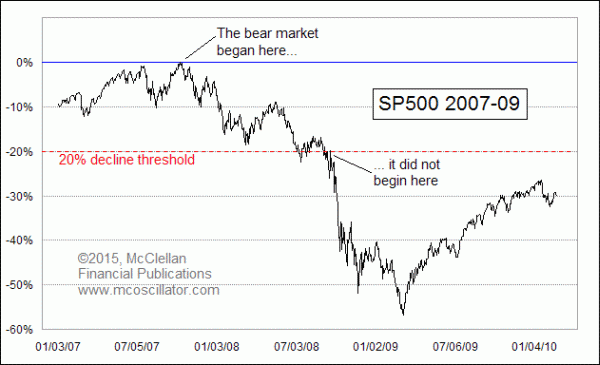Correctly Defining “Bear Market”

August 28, 2015
I am starting a personal crusade to expunge the notion of “10% is a correction and 20% is a bear market” from our collective lexicon. It is among the most meaningless, useless, and untrue statements out there.
The reason I dislike it so much is that it offers no insights about what a trader or investor should do. If you find the market down some percentage, and conclude that, okay, it is a “correction”, then so what? What does one do next?
Every 20% decline goes first through 10%. So if one says, “Oh well, it’s 10%, so it is just a correction,” then that would be similar to the guy who jumped off a 20-story building and was heard to say as he passed the 10th floor, “So far, so good.”
The chart above shows the stock market decline from the 2007 top to the 2009 bottom. I am going to assume that we can all agree that this was an example of a “bear market”. Having lived through it, I also know that early on during that decline, there were a lot of people who were saying that it was “just a correction”. This decline ended up traveling far beyond the 20% decline threshold. And it did not become a bear market upon crossing that line; it was a bear market the whole time, whether anyone knew it yet or not.
This helps us understand the point that defining the 10% and 20% thresholds as markers for categorizing types of declines is a functionally meaningless exercise.
Here is another point to consider, along the same lines. In the summer of 1998, there was a decline of 20% in the SP500 inside the span of 6-1/2 weeks. So since it was 20%, was it a bear market?

Of course not. It was a fairly brief (but scary!) pullback within what turned out to be a continuing uptrend, and with many more percentage points of upward movement to go before the final top in the year 2000. But if someone was using the silly “20% bear market” threshold, then he would have seen that it qualified as a bear market on exactly the bottom day. That would have been an unproductive conclusion.













Leave A Comment